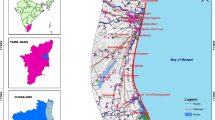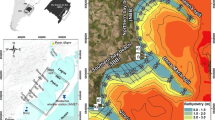Abstract
The proposed algorithm comprises three main steps. The first step is the evaluation of the sediment transport and budget. It was shown that the root segment of the Vistula Spit is dominated by eastward longshore sediment transport (up to 50 thousand m3/year). Over the rest of the spit, the shoreline’s orientation causes westward sediment transport (more than 100 thousand m3/year). The gradients of the longshore and cross shore sediment transport become the major contributors to the overall sediment balance. The only exception is the northeastern tip of the spit due to the appreciable imbalance of the sediment budget (13 m3m−1 yr−1). The second step in the prediction modeling is the estimation of the potential sea-level changes during the 21st century. The third step involves modeling of the shoreline’s behavior using the SPELT model [6, 7, 8]. In the most likely scenario, the rate of the recession is predicted to be about 0.3 m/year in 2010–2050 and will increase to 0.4 m/year in 2050–2100. The sand deficit, other than the sea-level rise, will be a key factor in the control of the shoreline’s evolution at the northeastern tip of the spit, and the amount of recession will range from 160 to 200 m in 2010–2100.
Similar content being viewed by others
References
V. P. Bobykina, in Proceedings of International Conference (School-Seminar) on Dynamics of Coastal Area of Low Tide Seas (Terra Baltika, Kaliningrad, 2008), pp. 37–38.
G. V. Vykhovanets, Eolian Process on the Sea Shore (Astroprint, Odessa, 2003) [in Russian].
Ya. S. Kobelyanskaya, in Proceedings of International Conference (School-Seminar) on Dynamics of Coastal Area of Low Tide Seas (Terra Baltika, Kaliningrad, 2008), pp. 56–58.
I. O. Leont’yev, Coastal Dynamics: Waves, Currents and Silts (GEOS, Moscow, 2001) [in Russian].
I. O. Leont’yev, “A Budget of Silts and Forecast of Coastal Area Development,” Okeanologiya 48, No. 3, 467–476 (2008).
I. O. Leont’yev, in Proceedings of the XXVIII International Coastal Conference on the Concept on Development of Marine Shores: Century Traditions and Contemporary Ideas (St. Petersburg, 2010a), pp. 81–83.
I. O. Leont’yev, in Fundamental and Applied Hydrophysics, No. 4 (10), 78–89 (2010b).
I. O. Leont’yev, “Modeling Beach Profile Evolution at Centennial to Millenial Scales,” Okeanologiya 52, No. 4, 550–560 (2012).
A. Sh. Khabidov, I. O. Leont’yev, K. V. Marusin, et al., Monitoring of the State of the Coasts and Reservoirs (Rus. Akad. Nauk, Novosibirsk, 2009) [in Russian].
Yu. D. Shuiskii, G. V. Vykhovanets, and T. A. Labuz, “Conditions and Numerical Values of the Eolian Sand Transfer on the Southern Coasts of the Baltic Sea,” Vestn. Odess. Univ. 11, No. 3, 148–165 (2006).
P. Bruun, “The Bruun Rule of Erosion by Sea-Level Rise: A Discussion on Large-Scale Two- and Three-Dimensional Usages,” J. Coastal Res. 4, No. 4, 627–648 (1988).
Coastal Engineering Manual EM 1110-2-1100, Wind-Blown Sediment Transport, part 3, Chap.4, iii-4-1–iii-4-77 (2002).
R. G. Hallermeier, “A Profile Zonation for Seasonal Sand Beaches from Wave Climate,” Coastal Eng. 4, 253–277 (1981).
J. R. Hunter, “Estimating Sea-Level Extremes under Conditions of Uncertain Sea-Level Rise,” Climate Change 99, 331–350 (2010). doi 10.1007/s 10584-009-9671-6.
T. Jednorał, Dynamics of Sea and Coastal Zone in the Gulf of Gda sk. Influence of the Planned Navigable Channel in the Polish Part of the Vistula Spit on Changes of Marine Hydrodynamic Processes on the Seaward Side of the Vistula Spit (Maritime Institute, Gdansk, 1996).
I.O. Leont’yev, in Advances in Coastal Modeling, Ed. by V. C. Lakhan (Elsevier Science Publ., Amsterdam, 2003), pp. 299–335.
Z. Pruszak, Marine Basins. Outline of Physical Processes and Environmental Engineering (Inst. Hydroengin., Gdańsk, 2003) [in Polish].
E. Van Wellen, A. J. Chadwick, and T. Mason, “A Review and Assessment of Longshore Sediment Transport Equations for Coarse-Grained Beaches,” Coastal Eng. 40, 243–275 (2000).
Author information
Authors and Affiliations
Corresponding author
Additional information
Original Russian Text © I.O. Leont’yev, 2012, published in Okeanologiya, 2012, Vol. 52, No. 5, pp. 757–767.
Rights and permissions
About this article
Cite this article
Leont’yev, I.O. Predicting shoreline evolution on a centennial scale using the example of the vistula (Baltic) spit. Oceanology 52, 700–709 (2012). https://doi.org/10.1134/S0001437012050104
Received:
Accepted:
Published:
Issue Date:
DOI: https://doi.org/10.1134/S0001437012050104




